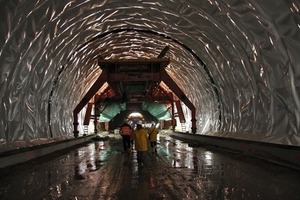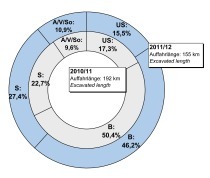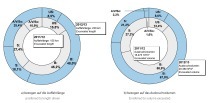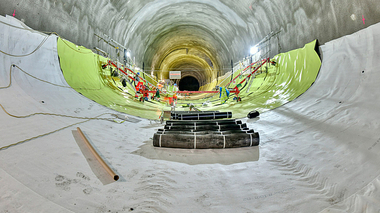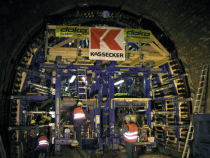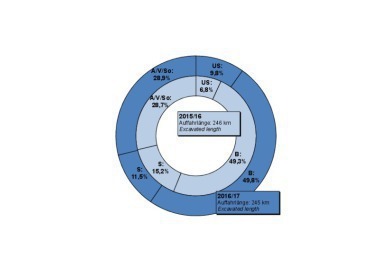Tunnelling in Germany:
Statistics 2008/2009, Analysis and Outlook
For more than 30 years, the STUVA has compiled statistics on tunnelling activities in Germany in keeping with a corresponding proposal put forward by the International Tunnelling and Underground Space Association [1].
1 Statistics on Tunnels under Construction 2008/2009
As in previous years, the STUVA also undertook a survey of current tunnelling projects in Germany at the turn-of-the-year 2008/2009. The outcome is compiled in tabular form for the month December 2008 and subsequently assessed. The table follows up its predecessors published for the years 1978 [2] till 2008 [3]. Only such tunnels and sewer structures, which possess an accessible excavated cross-section, i.e. a clear minimum diameter of 1,000 mm or including the pipe wall, a minimum cross-section of roughly 1 m2, are listed. On the other hand, trenchless small headings, which in recent years, have frequently been executed in conjunction with collector construction, the relevant domestic connections or also for pipe-jacking beneath rail and road facilities, are not taken into consideration.
The tunnel projects under construction at the turn-of-the-year 2008/2009 are not listed in detail; however, data can be obtained from STUVA’s Internet pages (http://www.stuva.de). In these tables, the numbering of the tunnel projects indicates the relationship with the data material stemming from previous years. Essentially it constitutes single or double identification letters, a two-digit continuous registration as well as a two-digit annual identification number. The identification letters serve to provide a brief assessment of the planned tunnel use:
US Underground (Metro), urban and rapid transit rail tunnels
B Main-line tunnels
S Urban and trunk road tunnels
V Water and other supply tunnels
A Sewage tunnels
So Miscellaneous tunnels
GS Basic refurbishing of tunnels.
Accordingly the identification number US 0108 indicates that it refers to a tunnel project with the ongoing number 1 from the field of Underground, urban and rapid transit tunnels, which was included for the first time in the statistics in 2008. The above-mentioned method of identification was selected against the background that the majority of construction sites, especially those from the transportation tunnel sector, run for 2 or 3 years or even more. This kind of registration has proved itself in order to avoid projects being counted twice and to identify the new construction volume that had to be included. Relevant pointers relating to the calculation of the construction lengths as well as the excavated volumes are contained in Table 1. Apart from the details for the turn-of-the-year 2008/2009, the figures from the two previous years are to be found there for comparison.
By and large, the tunnel lists on the STUVA home page provide information on the location and subsequent use of the tunnels that are included, their length and cross-sections as well as the soil conditions mainly encountered. The applied construction method is explained in brief and the scheduled construction time given. As far as possible, the clients, designers and contractors are named, in alphabetical order. Furthermore, constructional or technical aspects of a special nature are provided for many projects.
When comparing transportation tunnels with supply and disposal tunnels, information on the excavated volumes of the individual measures makes it possible to estimate the actual extent of the pertinent measures in a better manner than simply details of the lengths on their own. However, the following should be observed when comparing the excavated volume: whereas the excavated volumes for trenchless construction measures can be determined without any doubt, the comparative value for cut-and-cover methods can first be obtained by subtracting the amount of soil required for refilling from the total that was extracted.
Table 1 provides a picture of the overall tunnelling length under construction at the end of the year in question and the related construction volume. For the turn-of-the-year 2008/ 2009, Fig. 1 also contains the driven length and the excavation volume in accordance with the type of tunnel use shown in graphic form.
A general comparison of the figures in Table 1 reveals that the driven length of transportation tunnels again increased at the turn-of-the-year 2008/2009 with altogether some 138 km compared with around 111 km the previous year. Building activities on the Underground, urban and rapid transit sector grew significantly and there was also a clear increase registered in conjunction with main-line railway building compared with the previous year. As far as road building is concerned an upward trend is discernible.
If one considers the data relating to excavated volume, there is a length-related ratio of almost 26:1 as against a volume-related one of around 263:1 when comparing transportation tunnels on the one hand with supply and disposal facilities on the other (Fig. 1).
The question pertaining to the completeness of the data obtained from the survey carried out among construction companies and consultants is difficult to assess. In order to arrive at greater reliability in this respect, the cities engaged in Underground, urban and rapid transit construction activities, the Deutsche Bahn AG were requested to supply data within the scope of the 2008/2009 survey as was the case in previous years. The Federal Ministry of Transport, Building and Urban Affairs provided data for the federal trunk road tunnels [4]. In a large number of cases, the replies from these authorities as well as from the Deutsche Bahn AG resulted in important additions and corrections. At this point, a special word of thanks goes to the Federal Ministry of Transport, Building and Urban Affairs, the Deutsche Bahn AG, the other authorities and clients mentioned and the architects and construction firms involved for their assistance in compiling the statistics for current tunnelling projects.
In the following, the results of the survey as of December 2008 are evaluated more thoroughly in various ways in order to obtain an up-to-date overview of tunnelling in Germany. In order to substantiate this, the comprehensive explanations relating to the structures to
be found in “Underground Construction in Germany 2010”, containing a large number of examples presented in both illustrated and written form are referred to [5].
– This time around the main activities relating to inner-urban rail tunnelling (Table section US) took place in Cologne, where a total of almost 6.8 km of Underground tunnels was being built at the turn-of-the-year 2008/2009. Currently around 6.6 km of Underground tunnels is being produced in Hamburg. Further tunnel projects are being built in Berlin (3.6 km), Düsseldorf (3.3 km), Munich (3.2 km), Stuttgart (2.5 km) and Nuremberg (1.4 km).
– The length-related share of trenchless construction methods with regard to inner-urban rail tunnel construction amounted to 18.2 km at the end of 2008 – accounting for around almost 67 % (approx. 70 % the previous year) of the national construction volume overall for Under-ground, urban and rapid transit systems. Of this total, some 5 % was accounted for by shotcreting methods (4 % the previous year) and roughly 62 % (66 % the previous year) by shield driving. Fig. 2a provides a survey of the proportions accounted for by the various tunnelling methods. In this connection, the diagram in Fig. 3a shows the length-related proportion of trenchless construction methods in Underground, urban and rapid transit railway construction during the last 20 years. In this diagram, the division of trenchless construction methods according to shotcreting applications and shield drives is specially marked.
– The main-line railway tunnels contained in Part B largely relate to measures in conjunction with the new or upgrading construction programme for the high-speed lines of the Deutsche Bahn AG. Among the few current tunnelling measures taking place (Fig. 1) 2 further structures on the new/upgraded Erfurt–Halle/Leipzig route projects have been freshly tackled in the form of the Bibra (6.3 km) and Osterberg (2.1 km) tunnels. These tunnels – like the majority of the tunnels for the DB high-speed routes – are mainly built by trenchless means (Fig. 3b). The Finne Tunnel (6.9 km) part of the new Erfurt-Halle/Leipzig route, whose 2 tubes were excavated by shield drivage, forms an exception.
– Road tunnel construction (Part S of table) just like the 2 other transportation sectors, has constantly been subject to pronounced fluctuations in their commissioning in recent years. This becomes clearly evident from the award curve in Fig. 4 and above all, from the curve pertaining to the award and length-related proportions in Fig. 5. Road tunnels related to their lengths are driven both by mining means and by cut-and-cover in roughly equal proportions. In this connection, shotcreting together with drill + blast predominate in the majority of cases as far as trenchless projects are concerned (Fig. 3c).
In the parts of the table V and A relating to supply and disposal tunnels, only those with major diameters – as initially explained – are listed. The smallest cross-sections dealt with are roughly 1.0 m in diameter, the largest ones about 3–4 m. All of the supply and disposal tunnels assessed at the turn-of-the-year are driven by trenchless means. In the case of waste disposal tunnels, pipe-jacking continues to prevail as it has done in previous years. Furthermore, in compiling sewer statistics, it should be pointed out that only main collectors are dealt with here. The considerably greater part accounted for by collectors with smaller cross-sections mostly driven close to the surface by means of cut-and-cover, is not listed here, as generally speaking, this is not classified as tunnelling.
As far as tunnels under construction at the end of 2008 are concerned, their distribution according to federal states (Länder) is also of interest. Table 3 and Fig. 6 provide more details in this respect.
If one compares the newly obtained driven lengths and excavated volumes for the turn-of-the-year for transportation tunnels based on the statistics of recent years, then a revealing picture of just how contracts are awarded is obtained. In this connection, Fig. 4 clearly shows the important influence of the DB’s new lines and displays the ongoing fickleness on the part of public authorities in awarding new tunnelling contracts, something which constantly gives rise to complaints by the construction industry and consultants. After a steep rise in awards during the years 1996 till 1999 (resulting from activities in conjunction with the new Cologne – Rhine/Main route) an equally steep down-turn was registered over the next 2 to 3 years (Fig. 5). As a consequence, as far as providing work for the available capacities in the tunnelling industry (design and execution) is concerned, expectations are still concentrated on construction measures in conjunction with further new and upgraded lines for the Deutsche Bahn AG as well as on the national trunk roads sector (Chapter 2).
2 Planned Tunnelling Projects
The results of the survey relating to concretely planned tunnels and those to be commissioned in the near future are naturally of special interest to the construction industry and consultants. Table 2 presents the award period as from 2009.
When appraising the data in Table 2, it is evident that the relatively high volume of Under-ground, urban and rapid transit rail tunnels commissioned in previous years continues to diminish. In this connection, the remaining planned volume for the city of Munich accounting for almost 21 km stands out. Further tunnel routes of up to 3 km in length are planned for Stuttgart, Karlsruhe, Nuremberg, Duisburg as well as Berlin.
Regarding the particularly high proportion of main-line tunnels, it can be ascertained that this relates principally to the numerous tunnels for the projects involving the upgrading and new development of the route between Stuttgart and Augsburg – amounting to some 70 km, the Stuttgart 21 main line project involving roughly 57 km as well as the new Erfurt–Leipzig/Halle line involving almost 17 km of tunnel.
Furthermore the unaltered high volume of projected road tunnels continues to stand out. More than two-thirds of the listed projects concern the old (western) federal states (Table 4). The measures that are being planned in the new (eastern) federal states are mainly at the preliminary planning stage and, consequently, not yet sufficiently advanced to be included in the statistics. The planning on this sector is primarily being carried out in conjunction with the “German Unity Projects – Road”.
The 160 km of planned road tunnels listed in Table 2 has at least generally reached the planning approval stage. This applies at least for the tunnels on so-called federal trunk roads. i.e. those for which the federal government is responsible1. Furthermore, further road tunnels totalling almost 80 km in length are additionally planned. They have to be added to the figures contained in Table 2. For a part of these projects, the environmental compatibility test (UVP) has already been concluded or the route alignment has been determined. However, their realisation has not been absolutely secured, neither in terms of scheduling nor financing.
Technical details relating to the planned tunnels included in Table 2 are available in the relevant tables (available by ac-cessing http://www.stuva.de). Essentially they are divided up in the same manner as the statistics pertaining to tunnel projects that are in the process of being undertaken as presented in Chapter 1. The same approach was selected to identify and differentiate the individual tunnel projects. However, the letter “Z” has been added to make quite clear that the tunnel construction measure in question is a “future” one. As a consequence, no details are provided about the responsible construction company or consortium as are to be found in the statistics pertaining to current tunnel projects.
Generally speaking, as far as assessing the detailed data relating to future tunnel projects is concerned, it must be observed that alterations can occur during the planning approval or the award stages, above all, on account of special proposals, relating primarily to the tunnelling method. Various clients expressly pointed this out. Alter-nations can of course, also result with respect to the probable starting and completion dates for construction.
Is it also of interest for the construction industry and the consultants involved to be aware of the regions, in which the planned tunnel projects are primarily scheduled to be undertaken. Table 4 and Fig. 7 contain the relevant details split up in accordance with the federal states concerned.
3 Planned Tunnel Redevelopments
To an increasing extent, partial and complete refurbishing schemes are scheduled for old railway tunnels. Generally speaking, such measures call for rather special organisational and logistical considerations, above all, if they have to be undertaken without causing the disrupting of train services
(Fig. 2). Recent examples of this are provided by the enlargement of the cross-sections for 2 tunnels, which have been concluded in the meantime – namely the Jährodt and the Mausenmühlen tunnels on the line along the River Nahe between Bingen and Saarbrücken [6]. This route started operating in 1860. In the near future altogether the thorough development or profile enlargement of no less than 20 km of tunnel is scheduled. Table Section “ZGS” contains the relevant details. The identification and description of the new projects correspond with the future new construction projects to be found in Table 2.

